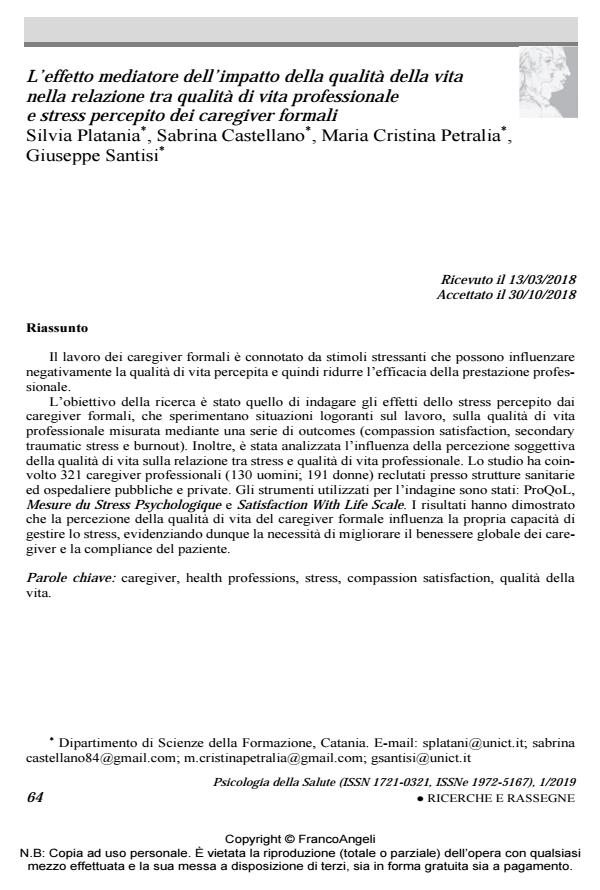The mediating effect of the impact of quality of life on the relationship between job satisfaction and perceived stress of professional caregivers
Journal title PSICOLOGIA DELLA SALUTE
Author/s Silvia Platania, Sabrina Castellano, Maria Cristina Petralia, Giuseppe Santisi
Publishing Year 2019 Issue 2019/1
Language Italian Pages 20 P. 64-83 File size 320 KB
DOI 10.3280/PDS2019-001004
DOI is like a bar code for intellectual property: to have more infomation
click here
Below, you can see the article first page
If you want to buy this article in PDF format, you can do it, following the instructions to buy download credits

FrancoAngeli is member of Publishers International Linking Association, Inc (PILA), a not-for-profit association which run the CrossRef service enabling links to and from online scholarly content.
The work of professional caregivers is characterized by stress events that can negatively affect the perceived quality of life, thus reducing the efficacy of the professional service. The aim of the present study was to investigate the effects of the stress perceived by professional caregivers, who are exposed to stressing events, and their career’s duration on some parameters of professional satisfaction (compassion satisfaction, secondary traumatic stress e burnout) in workers exposed. We also verified if the subjectively perceived quality of life affects the relationship between the stress and the professional satisfaction. 321 professional caregivers (130 man, 40.5%; 191 woman, 59.5%) were recruited in both public and private clinics. The following tools were used: ProQoL, Mesure du Stress Psychologique e Satisfac-tion With Life Scale. Results demonstrated that the quality of life perceived by professional caregivers affects their stress management ability, thus highlighting the need to improve both their overall wellbeing and the patients’ compliance.
Keywords: Caregiver, health professions, stress, compassion satisfaction, quality with life
- Health Occupation and Job Satisfaction: The Impact of Psychological Capital in the Management of Clinical Psychological Stressors of Healthcare Workers in the COVID-19 Era Pasquale Caponnetto, Silvia Platania, Marilena Maglia, Martina Morando, Stefania Valeria Gruttadauria, Roberta Auditore, Caterina Ledda, Venerando Rapisarda, Giuseppe Santisi, in International Journal of Environmental Research and Public Health /2022 pp.6134
DOI: 10.3390/ijerph19106134 - The Effect of Psychosocial Safety Climate on Engagement and Psychological Distress: A Multilevel Study on the Healthcare Sector Silvia Platania, Martina Morando, Alice Caruso, Vittorio Edoardo Scuderi, in Safety /2022 pp.62
DOI: 10.3390/safety8030062 - Dispositional Resilience as Mediator in Psychological Stress on Healthcare Workers: A Multi-Group Analysis of Frontline and Non-Frontline Workers Silvia Platania, Stefania Valeria Gruttadauria, Martina Morando, in European Journal of Investigation in Health, Psychology and Education /2022 pp.1285
DOI: 10.3390/ejihpe12090089 - Cross-Cultural Adaptation, Psychometric Properties and Measurement Invariance of the Italian Version of the Job Satisfaction Scale Silvia Platania, Pasquale Caponnetto, Martina Morando, Marilena Maglia, Roberta Auditore, Giuseppe Santisi, in European Journal of Investigation in Health, Psychology and Education /2021 pp.1073
DOI: 10.3390/ejihpe11030080
Silvia Platania, Sabrina Castellano, Maria Cristina Petralia, Giuseppe Santisi, L’effetto mediatore dell’impatto della qualità della vita nella relazione tra qualità di vita professionale e stress percepito dei caregiver formali in "PSICOLOGIA DELLA SALUTE" 1/2019, pp 64-83, DOI: 10.3280/PDS2019-001004